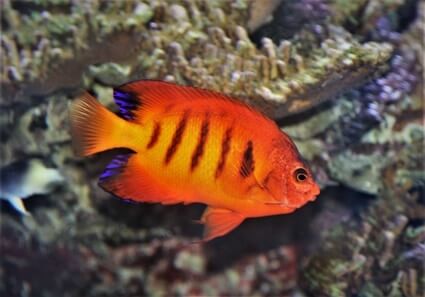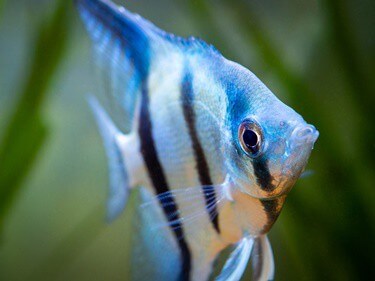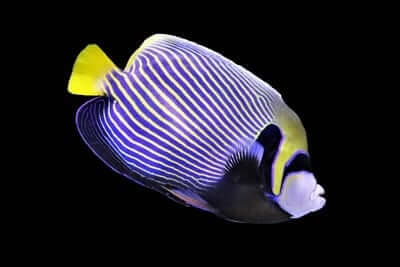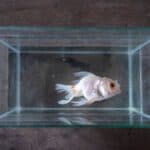Last Updated on: 23rd April 2024, 06:49 am
Angelfish change colors due to age, illness, unhappiness, stress, aggression, mating behavior, and the room’s brightness. The vertical stripes don’t change color but often appear, reappear, and fade.
Angelfish can go months without changing color. At other times, they may change color once or twice daily. Sometimes, angelfish will subtly change color, meaning you won’t notice.
Color alterations are only concerning when coupled with odd behaviors and other physical changes.
How Can Angelfish Change Color?
Angelfish have chromatophores, which are cells that contain pigments and reflect light.
Chromatophores are responsible for the skin and eye color of cold-blooded animals. However, angelfish have more freedom with their chromatophores, meaning they can change colors.
Chromatophores require energy to control the hue of the fish.
The resulting lack of energy will manifest in its colors if the fish is ill, under stress, or malnourished. This color can be regained by sleeping adequately, eating well, and remaining stress-free.
When Do Angelfish Change Colors?
Some angelfish will change colors in minutes, while others gradually adjust.
Seeing a once vibrant fish slowly turn pale can be anxiety-inducing, but we can identify the reason.
Sleep
When angelfish sleep, they often lose their color. Like any living organism with tissues and cells, angelfish get microtears in their brains and muscles as the day progresses.
While they sleep, their body can focus on regenerating these microtears. Instead of using the energy to keep the skin’s pigment vibrant, the color usually becomes dull when the angelfish sleeps.
Once awake, the skin returns to its natural, vibrant self. This process is usually quick, and the angelfish doesn’t take long to go from dull to colorful.
It may be difficult to tell when angelfish are asleep. They don’t lie down at the bottom of the tank and stay still. Instead, they enter a sleep-like state where they swim slowly or are inactive.
It requires less energy than swimming, allowing angelfish to replenish their energy. Once the angelfish regains its natural color and seems livelier, it has awoken.
Aggression
The color of an angelfish becomes more intense when fighting. They use this tactic to:
- Establish dominance.
- Frighten their opponent.
- Confuse the senses of other fish.
When something in a fish’s field of view is exceptionally bright, it catches its eye and makes it wary. It can’t concentrate when overwhelmingly bright colors dominate its vision.
If the angelfish’s color suddenly becomes bright and it swims rapidly around other fish, it signifies aggression. Consider separating the aggressive angelfish from the others.

Hunger
When an angelfish is hungry or has a poor diet, its color will fade.
See if the angelfish can reach the food before it’s all out. If not, temporarily separate the angelfish into a different tank so the sickly fish can focus on eating and recovery.
An angelfish’s skin may become more vibrant to catch your attention when it’s hungry.
Illness
Sick angelfish lose their color. This depends on their illness and the rate of progression. So, the color change may happen quickly or slowly.
If you’re unsure if the fish is sick, see if it’s also behaving strangely. You should notice:
- Unusual swimming patterns.
- A lack of appetite.
- Holes, bulges, or spots.
- Torn fins.
- Protruding or lost scales.
- Attacks from other fish.
A sick fish won’t have the energy to maintain its cellular operations, which will prevent the body from controlling its hue. As the body deteriorates, so do the cells and chromatophores.
Water Quality
To live a healthy life, angelfish have specific needs for their water. Everything from the pH levels to the water temperature must be optimal. Otherwise, the fish will grow sick and stressed.
How fast will an angelfish’s color change? The fastest color changes happen when the oxygen levels are low, as the fish swim to the water’s surface to breathe.
Stress
It’s easy to tell when something is wrong (or right) because of how its color alters. When stressed, angelfish will fade in color. The more stressed, the sooner this happens.
- If it’s caused by aggressive behavior from another fish, the angelfish will turn pale quickly.
- The change might happen slowly due to parental stress in gravid angelfish.
Injury
Angelfish will fade in color due to physical injuries. The body may forgo the cellular procedures responsible for maintaining color and focus on regenerating tissue.
Mating And Breeding
According to the University of Leiden, cichlids choose their mates based on color. Male angelfish brighten in color when trying to impress female angelfish. Bright colors mean the male is:
- Strong.
- Dominant.
- In robust health.
In a fight for dominance, a frightened angelfish will attempt to hide. This is achieved by fading its colors and blending in with the background. Consequently, dull colors imply weakness.
Once angelfish choose their mate and are paired, they’ll continue to have bright coloring. This will intimidate other fish, preventing them from getting close to their mate or eggs.
Vitality
Vivid colors imply good health. This brightening is slow, especially if fish are recovering from illness.
Age
As angelfish grow, they become stronger, resulting in more colorful scales. The opposite happens when an angelfish is old because it may not be able to maintain its scales like it used to.
Food Quality
Low-quality food may lack nutrients, leading to dimmer colors. After changing the type or brand of fish food, it’s common for the fish to change hues.
Environment
As chromatophores absorb light, the brighter the room, the more colorful the angelfish.
When asleep, an angelfish’s color will fade faster when the lights are off. This change happens relatively quickly due to how light-absorbent chromatophores are.
Is the tank in an active area of the home? If so, move the tank to a more secluded area.
Why Do the Stripes on Angelfish Fade?
Angelfish fade their stripes to blend in with plants and hide from predators. An angelfish in an aquarium will fade its stripes even more if no plant life exists.
This will be paired with hiding at the bottom of the tank. It may try to match its stripes to the color of the rocks and sand, and it’ll stay there until it feels the danger has passed.
The more frightened the angelfish is, the more the stripes will fade. Sometimes, the stripes will disappear completely. Of course, this means that the fish is stressed, so the problem must be addressed.
Angelfish Color Meanings
Do specific colors have meanings? While it’ll vary from fish to fish, a few generalized meanings exist.
Angelfish Turning Yellow
Angelfish may turn yellow depending on their sub-species. For example, zebra angelfish or silver angelfish may take on a yellow hue when mating, stressed, or even randomly.
However, other angelfish become yellow due to poor water quality or overcrowding. Check the tank’s chemical balance and water levels. If too many fish are in the tank, you should separate them.
Angelfish Turning Red
Redness in angelfish signifies ammonia poisoning if it’s not an iconic color for its breed. This isn’t just a change in hue, but burns appearing on the fish.
Changing the water more frequently and checking the chemical balance is essential.

Angelfish Turning Green
A green hue in angelfish signifies they’ve contracted Velvet Disease or another sickness. That’s extremely negative, especially when paired with irregular swimming habits and heavy breathing.
Check the water quality and the tank’s temperature, making corrections to aid recovery.
Angelfish Turning White
Angelfish may turn white due to a lack of oxygen in the tank. This causes their stripes to fade and their brighter colors to dim. This will give them a grey, washed-out look.
You may also find the eggs are turning white due to fungi.
Angelfish Turning Orange
If an angelfish suddenly brightens to an orange around the dorsal fins, you have a koi angelfish.
It’s common for them to be kept in poor, over-packed conditions in pet stores. This causes them to fade in color, losing their orange hue.
New owners may buy the fish when that happens, believing it’s a different sub-species.
Angelfish Turning Black
Black usually means it’s comfortable. After all, white is more prominent when the stripes fade, as the fish may seem blacker when these stripes brighten up again.
This is a natural change if the angelfish has recently been transferred from a pet store.
Angelfish Turning Brown
If an angelfish turns a light brown, this may be a natural part of its color-changing habits. The black stripes may dull as the fish sleeps and appear brown. Light changes may also cause this hue to fade.
However, if the angelfish turns dark brown and maintains this color, it may have Velvet Disease. This will cause the fish to turn gold, brown, or green.







